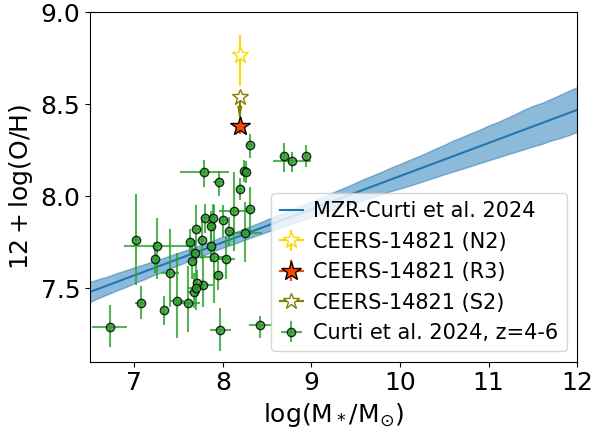This week’s paper is:
Spectroscopic confirmation of a dust-obscured, metal-rich dwarf galaxy at z~5
[astroph]
L. Bisigello et al.
This paper is a short letter pointing to the spectroscopic confirmation of a dusty dwarf at z=5. There are a few things remarkable about this object. It’s a metal- and dust-rich dwarf galaxy. Those are supposed to be metal poor and pretty much transparent. And that this galaxy is doing this at z=5!
The evidence for both dust extinction and the metal content comes from spectroscopy with James Webb Space Telescope for the Cosmic Evolution Early Release Science Survey (CEERS). JWST will make spectroscopists of us all yet.

Dust
The dust in this low-mass galaxy does two things. First it does not show in Hubble images. There could be a whole population of these at higher redshift that we are missing up till now!
Secondly, it reddens the emission that we now see with JWST. This was the optical emission (rest-frame optical means it was an optical photon when it left, the travel from z=5 to now means it’s been redshifted to infrared when we detect it. Travel is hard on these poor photons).
We measure this reddening with the ratio of two emission lines from the Hydrogen atom: H-alpha and H-beta. If this is a “normal” 40.000K plasma around newly formed stars, these lines are shining in an expected ratio.
However, the longer wavelength one will be dimmed preferentially by interstellar dust. The observed ratio between H-alpha and H-beta thus tells us how much dust reddening happens(very similar to a sunset next to a refinery).

The two stars (green and red) are the amount of reddening in this small dwarf galaxy (I mean that is 100 million solar masses, its small). It shows that this galaxy is optically thick. There is no looking through this thing.
Metals
And secondly, the ratio of emission lines of Hydrogen and Oxygen tells us what the level of heavier elements is(astronomers call everything heavier than Helium a “metal”. Most of it is Oxygen anyway. Drives Chemist nuts).

And as we can see our dwarf CEERS-14821 is high on the y-axis, which is the ratio of Oxygen over hydrogen. Lots of dust and lots of metals.
And now on why that is weird: small galaxies lose their interstellar matter quite easily. One supernova and poof, it’s blown out. A bigger galaxy is near, they lose it to that. Meanwhile this one has kept a lot of it.
If this was a unique case, that would be one thing. But at z=5, it is entirely possible that these dusty, metal-rich dwarfs are a common sight. It could well be that a lot of star-formation at that redshift is happening in these dusty dwarfs, hiding much of this from our observations up till now. How that first build-up of galaxies and stars works is still quite a mystery.
No comments:
Post a Comment